Resistance of Epoxypolymer with 2 - 5 wt% Nanosilica in Aggressive Acid Medium ()
1. Introduction
Introduction of nanoand micro-additives is commonly used for improvement of industrial compositions properties [1-19]. One promising areas of the research is the study of nano-additive’s impact on resistance to aggressive environment and atmosphere. Effect of NS-surface structure on chemical resistance and durability of polyepoxide composites continues to be debated. For example, nanosilica (0.5 - 3 wt%) is used as an additive for epoxy matting floor covering [2-10], in the paint [1,5], dental [4], and electrical [7] industry. Silica additives provide incensement of thermal stability [11,18], and chemical resistance to water [9,10,13], organic [10,17] and other environments [8-10,12,16,19]. The influence of atmospheric effects on the processes of structure and properties of epoxy coatings has also been studied [1]. Improvement of properties and increase of the chemical resistance of composites are achieved by NS surface modifying and defining of optimal concentration of NS [5-11] and other dispersed fillers [3].
For today, there is a lack of data about the influence of specific surface area (S) of nanosilica on the chemical properties of the composites. Different works [8-10,15] have shown that the specific surface area is an essential factor with a significant influence on the properties of epoxy composites. However, the study of stability in aggressive environment has showed that the dependence of the chemical resistance from S is hard to establish. For example, some articles [8,10] have reported about failure to establish a correlation between the swelling rate and S in water and hydrochloric acid, perhaps due to the temperature of the experiment (20˚C - 25˚C). Here we present investigation results of the effect of dispersed fillers surface modification on the swelling and chemical resistance of NS.
2. Experimental Part
A study on the degree of dependence of swelling (q) of the concentration, nature and specific surface of nanosilica (“Aerosil” type) was carried out in this paper. Studies were carried out for 1 month at 11˚C ± 2˚C. The mass of samples were 85 ± 10 mg (U) and 110 ± 10 mg (U'), for which data were averaged.
Standard epoxy (EP) matrix based on dyanepoxyresin ED-20 (see formula (1), UfaKhimProm Russia product) + 12.5 wt% of polyethylentpolyamine (PEPA), was filled with C = 2 wt% (or C = 5 wt%) by nanosilica “Aerosil” A-50, A-100, A-175, A-300, A-455 (where the number corresponds to the specific surface area S in m2/g). Aerosil were used: A-50—produced by Degussa (Germany), others—the own production of Institute of Surface Chemistry, Kalush factory (licensed production of nanosilicas TM “Asil” and “SILIKS” (with 100 < S < 400 m2/g [4a]). Aerosil modified by acrylate silane (A-174), complex “methyltriethoxysilane-polyester resin” and complex “methyltriethoxysilane MTES—epoxy resin ED-5” were used. Aerosils were introduced into epoxy matrix, mixed and incubated for 1 - 2 months, time to time carrying additional mixing of heated composition. At the end of the process the “ripening” composition was heated and introduced 12.5% of PEPAintensive stirring for 5 - 10 min, to reduce the air bubbles in the batch mixing carried by spiral movements of the pointed stick (“mini-mixer”), then to maximize the removing of single air bubbles composition briefly heated (70˚C - 90˚C, 2 - 3 min). At the end of the homogenization of the air-cured with subsequent exposure of the samples cured for 1 - 2 months. After that, without additional heat treatment, the EP-samples were placed in corrosive liquids.


For study of the swelling of filled compositions, the lenticular samples 1 cm in diameter and 2 - 3 mm thick have been used. They were immersed into a concentrated nitric acid (c.HNO3) in the polyethylene-stoppers crucibles. Swelling was estimated by change in weight of composites  (m1 and mo—current and the initial sample mass) after 40 - 60 min of drying at room temperature. Initial and filled samples were studied by electron microscopy (SEM) and X-ray analysis. The lifetime L of the sample was defined as the time of transition from solid to viscous (not weighed) state.
(m1 and mo—current and the initial sample mass) after 40 - 60 min of drying at room temperature. Initial and filled samples were studied by electron microscopy (SEM) and X-ray analysis. The lifetime L of the sample was defined as the time of transition from solid to viscous (not weighed) state.
3. Results and Discussion
3.1. Nature of Change of EP-Samples under the Influence of the CA Depending on the Content of Silica
Visual analysis points out that processes of decomposition of EP-composite in c.HNO3 take place with obvious formation of low-molecular products and NO2, which leads to a rapid color change (browning) of the samples. Thus, at day 2 samples lose their transparency and colorless (or whitess), but almost all keep the original shape and luster (Figure 1(a)). On the 4th day some of the SiO2- filled samples begin to delaminate. As you can see in Table 1, the process of swelling of unfilled PE sample (U + U', shown in Table 1 and Figures 2-5) proceeds rapidly. After 1-day of exposure in c.HNO3 it swells by 21.5%, after 4 days—on 40%, after a week—by 70% - 80%.
3.2. The Swelling Curves: Influence of Silica
The curves of swelling in c.HNO3 did not have an asymptotic plot of saturation so we would not be able to calculate their basic characteristic like coefficient of diffusion D. In this case, real rate of swelling W (%/days) was elected as a characteristic of process (Table 1).
Figure 1(b) shows the swelling process can be divided into 4 stages.
1) At the first stage (0 - 1 days) the rate of swelling reached 20% per day. The first stage is characterized by high speed of penetrating of acid solution in pores of EPcomposite; yellowing of samples suggests about the primary chemical destruction processes.
2) At the second stage (1 - 7 days), the process is stabilized, and W ≈ 7%/day. It shows complete filling of pores in the polymer by c.HNO3 and the continuation of the normal process of swelling. Simultaneously the process of destruction is accelerated (browning of the samples) (Figure 1(b)).
3) At the third stage (7 - 14 days), swelling reaches the 80% - 100%, and the sample transforms to elastic pasty mass with bubbles of CO2 and NO2, with brown-yellow color.
4) At the fourth stage the sample transforms to the foam forming yellow solution.
Hence a resistance of unfilled EP-composite c.HNO3 composes 1 - 2 weeks, and due to process of decomposition, samples have increased their masses almost in two times— average is 180% ± 10%.
The influence of non-modified nanosilica on q depends on their specific surface area. As shown in Table 1 and Figures 2 and 3, an introduction of 2% of nanosilica into the composition leads to decreasing of q, and not increase the lifetime of the composition. The value of this decreasing ∆q = qU – q (qU—for unfilled, q—for current filled EP-composite) can reach 20% - 25% for A-300, and consists 3% - 10% for other silica. Since 1 day of exposure, we also note a correlation of q-1/S (S—specific surface of silica, m2/g)—reduction of the q and W with a increasing of S. In the first few hours (for example, 0.06 days, Table 1) filled samples swell more eagerly than unfilled. It suggests about changes of macro-porosity of the composites after filling.
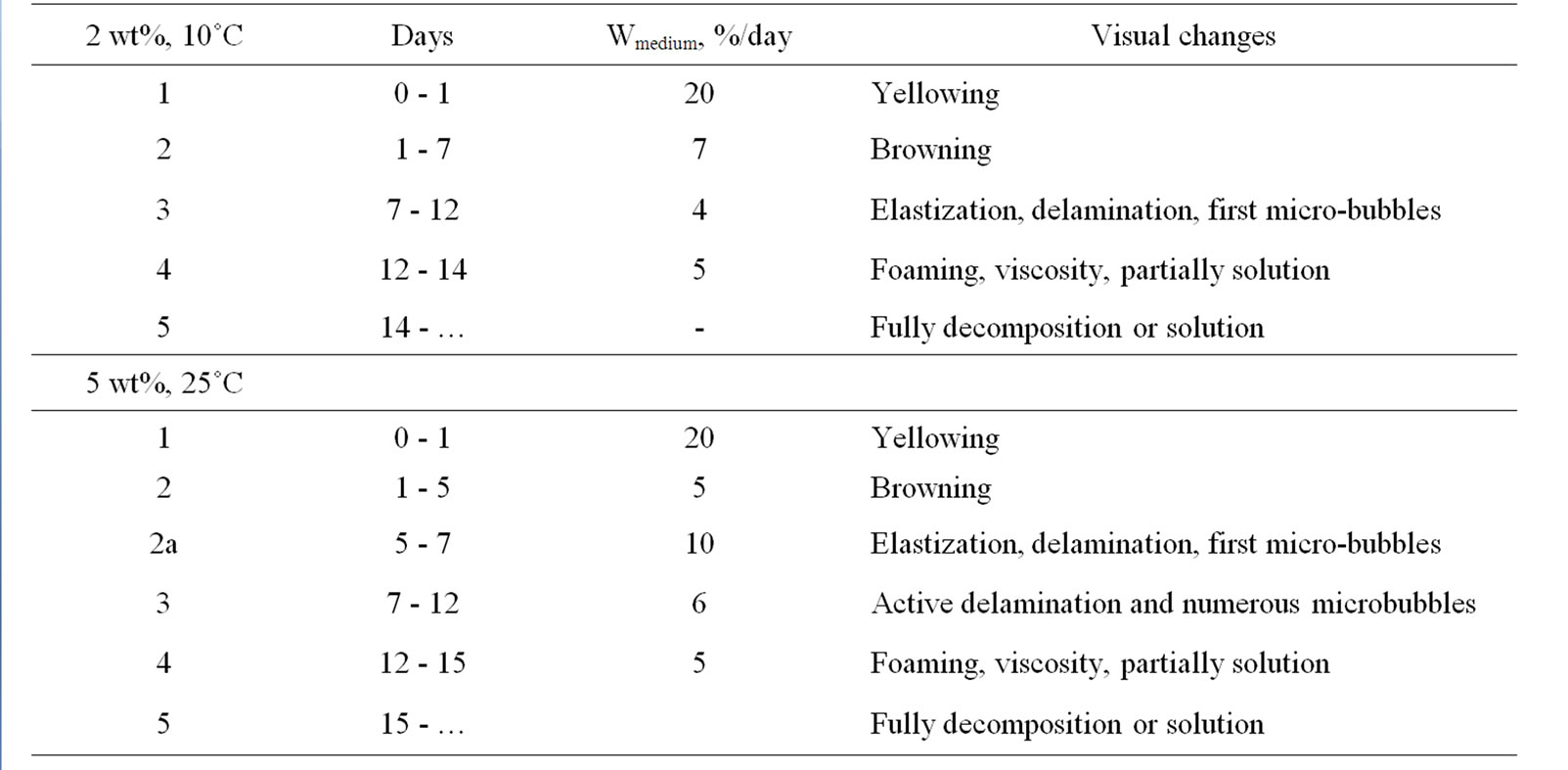
Table 1. Stages of swelling in c.HNO3 for EP-composites.
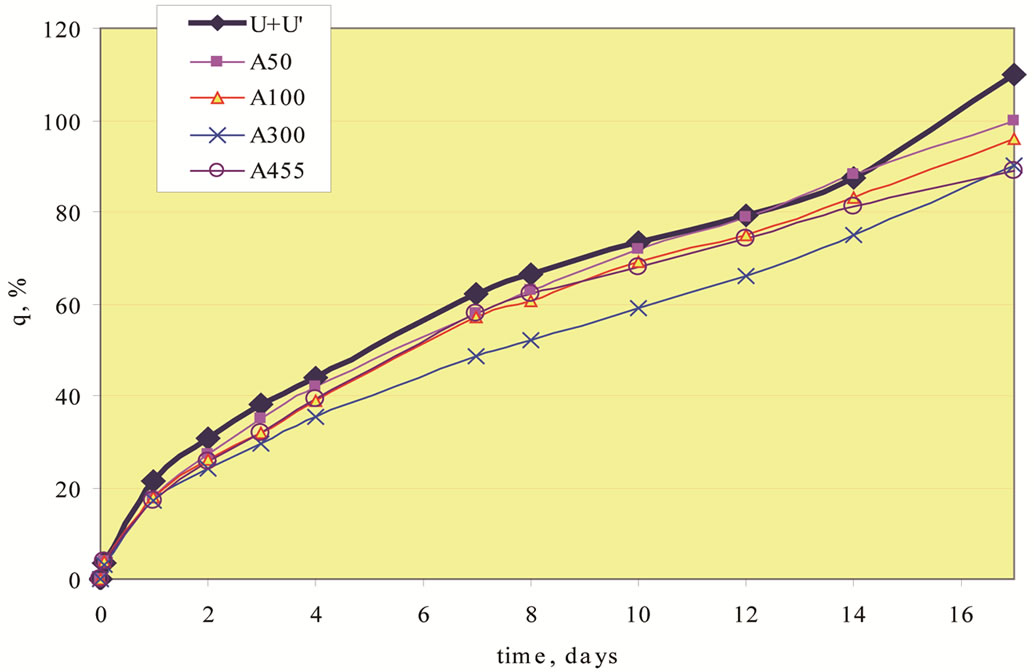
Figure 2. The curves of swelling (11˚C) in the concentrated HNO3, samples with 2 wt% of unmodified NS.
Swelling-curve of composite with low-disperse A-50 copies the shape of the curve for unfilled sample, i.e., the effect of low-disperse silica is insignificant. During the first day the difference is not significant (q indexes are the same) for NS brands A-50 and A-100, when the rate of swelling of the sample with the A-100 is reduced. The influence of high-dispersed silica A-300 (S = 340 m2/g) for q is noticeably from the first minutes of exposure in c.HNO3, and at all stages q  qU (after filling q decreases on 20% - 23%). Note that ultra dispersed A-455 satisfies correlation “q-1/S” only at t ≤ 1 and t ≥ 17 days (Figure 3).
qU (after filling q decreases on 20% - 23%). Note that ultra dispersed A-455 satisfies correlation “q-1/S” only at t ≤ 1 and t ≥ 17 days (Figure 3).
Experimental data shows that filling by 2 wt% of modified silica cannot strengthen composite resistance to swelling in c.HNO3. As can be seen from Figure 4, filling with 2% of modified silica does not lead to a strengthening of chemical resistance, as W ≈ WU, and life-time L ≤ LU. By increasing concentration C from 2 wt% to 5 wt% of modified silica (sample AK5), the chemical resistance of composite is increased. This is clear from the substantial (in 1.5 times) reduction of swelling for sample “epoxyresin + 5 wt% A-100/mod.A- 174” (sample ak5, Figure 4).
The results of swelling for 5 wt%-filled EP-composite at 25˚C (Q) confirm a possibility to improve durability in c.HNO3 by modifying the surface of silica. The unmodified A-300 actc as a “worsening additive”, due to increasing of swelling and decreasing of life-time of EPcomposite (Figure 5). But modification by A-300 by contrast enhances effect. The most part of “EP + mod. A-300” has a smaller swelling q < qU (compared with qU for unfilled EP) at 1 - 12 days.
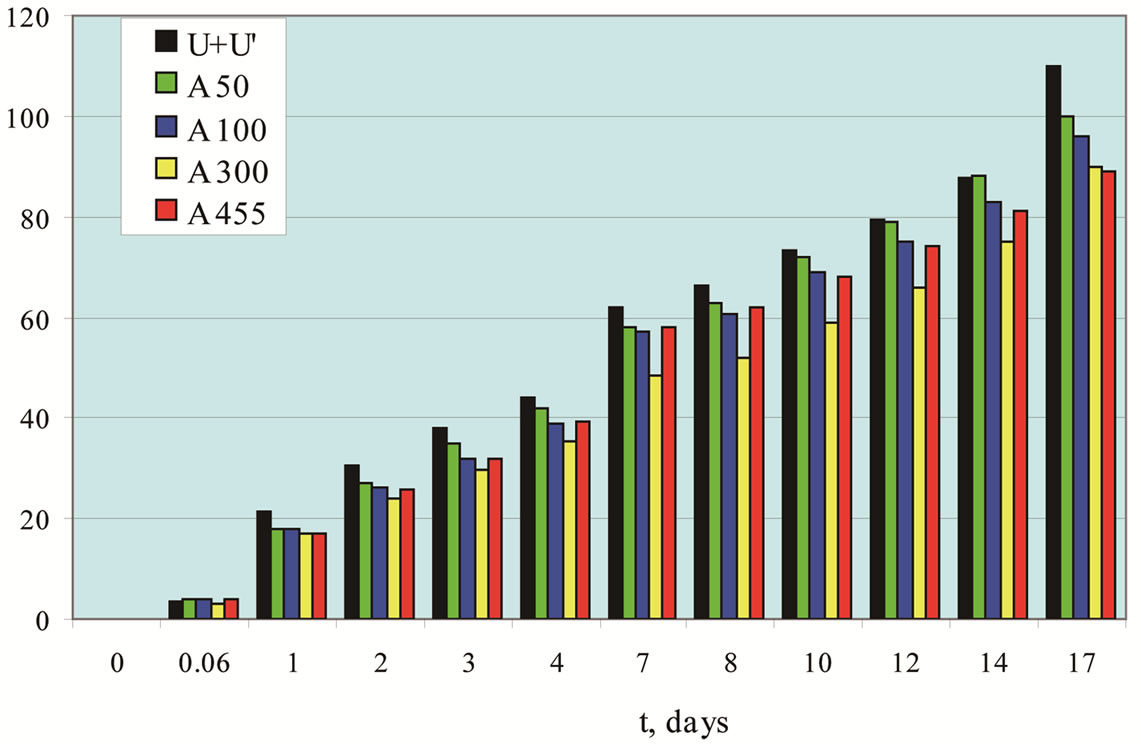
Figure 3. Histogram of the samples with 2 wt% unmodified aerosil swelling (black column—averaged values—of q for the unfilled samples).
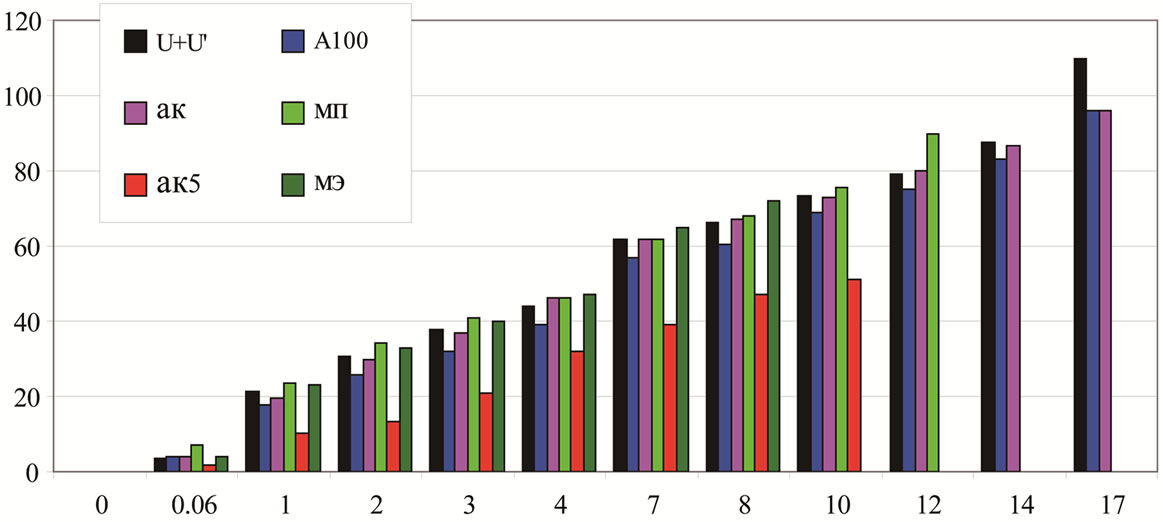
Figure 4. Histogram of swelling of the samples with 2 wt% (for ak5—5 wt%) A-100 and its modified forms (black column—the average value for the unfilled samples).
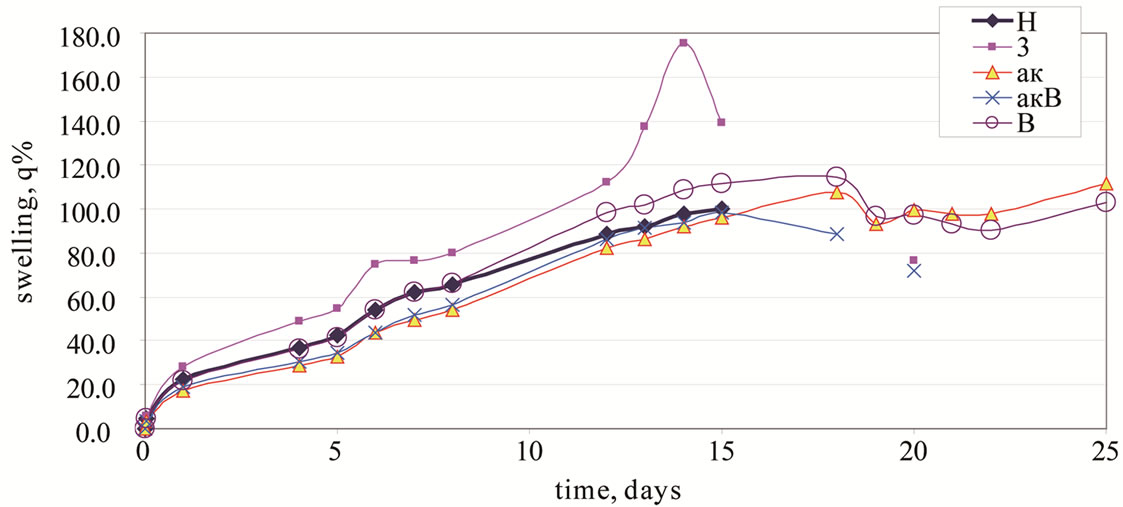
Figure 5. Swell curves in c.HNO3 (25˚C) for EP-templates with 5 wt% of silica: H: unfilled; 3: aerosil A-300; ak: A-300/ mod.acrylsilane A174 (monolayer); akB: A-300\mod.acrylsilane A174 + olygoacrilate Bis-GMA; B: A-300/mod.olygoacrilate Bis-GMA (monolayer).

Figure 6. The visual shape of EP-template “B”—initial thick (up) and after 12 days in c.HNO3 (ball-like).
The maximum on curve “3” (for A-300) at 14 days and weak maximums for other curves can have next explication. The presence of inorganic phase (silica) causes the penetration of HNO3-molecules into a polymer network to increase. At definite time, the excess of swelling leads to the degradation and destruction of polymer, because of q-value decreasing. For modif.A-300 (curves ak, akB, B on Figure 5), hydrophility of NS-phase is weaken (compare unmod.A-300) and maximum peaks are less (Figure 5). The time 8 days can estimate as boarder time, after that the increasing of W takes place, and q → qU (in some cases q > qU). After 12 days (analogically to 2 wt% at 10˚C, Figure 4) q ≥ qU for all composites—excluding composite “ak” with A300/mod. A174.
The obvious increasing of chemical durability in c.HNO3 takes place in case of filling by A300/mod.A174 (Figure 1). Modification of A300 with an acrylsilane A174 can prolong a life time of EP in 1.5 time (15 days for unfilled EP, 25 days for “ak”, Figure 1), and at the same time a swelling obviously decreases (qak < qU). It can reflect the formation of more stable and less-penetrating polymeric chain compаred with unfilled or unmod.A-300 filled EP-composite.
Increasing of q after filling as a rule can be evaluated as a negative factor (that is obvious for A-300, Figure 1), but in some cases it is a positive factor. For A300/mod. Bis-GMA, increasing of q due to maximal elasticity, that let prolong life-time of EP-composite. At last stages (20 - 25 days), composite swell at q ≥ 100%. As a result, the template transforms from lensto ball-form (Figure 6), but does not decompose during 25 days, whereas unfilled EP (or EP filled by pure A300) decomposes after 15 days (Figure 1).
Thus, the introduction of nanosilica in the epoxy composite is capable to reduce at 10% - 30% the degree of swelling in concentrated nitric acid, depending on exposure time and specific surface area of NS. At some conditions (10˚C) the correlation q ~ 1/S (S—surface area of NS) takes place. Modification of NS by silanes and acrylates can increase the chemical resistance of composites at optimal concentrations and modificators of NS. For example, q < qU and L  LU (qU and LU—for Unfilled EP-composite) for 5 wt% unmod.A-100 and A-300 modified by propylmethacrylate-trimethoxysylane A174, or A-300, modif.by Bis-GMA.
LU (qU and LU—for Unfilled EP-composite) for 5 wt% unmod.A-100 and A-300 modified by propylmethacrylate-trimethoxysylane A174, or A-300, modif.by Bis-GMA.
Change of the chemical resistance of composites under the influence of small additions of nanosilica is primarily due to its influence on the structure of the composites. This is illustrated by TEM-micrographs and X-rays of composites are shown in Figure 7. As can be seen from the figure, the structure of unfilled epoxy composite (A) is almost homogeneous, and filled (2 - 5 wt%) by silica A-100/mod. A-174 (B) and A-100/mod.MTES + ED-5 (B)—nanoheterogenous structure (two-phase). The size and shape of aggregates of the dispersed phase of silica in polyepoxide matrix depend on the type of modified silica.
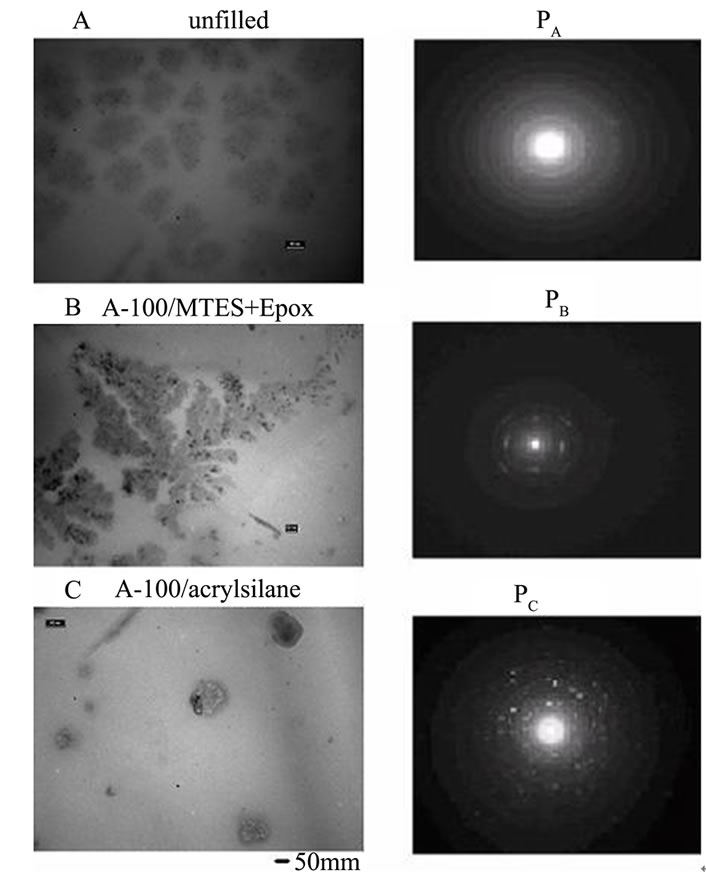
Figure 7. Photomicrographs and X-ray of unfilled sample polyepoxides (A) filled with 2% aerosil A-100, modified MTES and ED-5 (B) and modified by acrylate silane A-174 (C).
It can be seen in roentgenograms of the composites that the introduction of modified silica leads to a change in the structure of the composite, for example, in the form of ordered zones. So, after filling, on X-ray images are visible white blotches. Such inclusions, according to [20,21], are characteristics of the crystallization zone or structure in the polymer matrix. This means that the introduction of modified aerosil may create a zone in the polymer with a more ordered structure, like a crystal. The number of these zones depends on the method of modification. They are visible on a roentgenograms of a composite with SiO2/modif.by silane MTES (Figure 7, sample B). Even greater extent, such changes can be seen in the sample B (Figure 7)—with silica modified by A- 174 (sample “AK5”), and this could explain the increased chemical resistance in conc.HNO3 after filling this polymer with silica.
4. Conclusions
1) Introduction of nanosilica leads to increased chemical resistance of polyepoxides in aggressive environments, which is illustrated by the example of swelling of the composites in concentrated nitric acid.
2) Swelling of the filled polyepoxides in concentrated HNO3 depends on the specific surface of silica. Under certain conditions (10˚C) decreasing of swelling rate correlates with increasing of specific surface area.
3) The surface modification of silica is an effective way for increasing of a swelling resistance of the composite polyepoxides.
4) TEM and X-ray analysis of polyepoxide samples showed that modification of silica surface leads to a noticeable change in the structure of the composite. In particular, that is possible due to formation of SiO2-nanoinclusions in the polymer and ordered zones in the structure of the polymer.